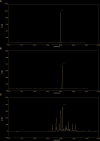Phyllolobium chinense Fisch Flavonoids (PCFF) Suppresses the M1 Polarization of LPS-Stimulated RAW264.7 Macrophages by Inhibiting NF-κB/iNOS Signaling Pathway
- PMID: 32625088
- PMCID: PMC7314944
- DOI: 10.3389/fphar.2020.00864
Phyllolobium chinense Fisch Flavonoids (PCFF) Suppresses the M1 Polarization of LPS-Stimulated RAW264.7 Macrophages by Inhibiting NF-κB/iNOS Signaling Pathway
Abstract
Background: M1 macrophage plays an important role in inflammatory reaction. In this study, potential anti-inflammatory effect of Phyllolobium chinense Fisch flavonoids (PCFF) was assessed via Zebrafish acute inflammation model in vivo and LPS-induced pro-inflammatory M1 macrophage model in vitro.
Methods: The quality control of P. chinense Fisch flavonoids (PCFF) was analyzed by HPLC. Anti-inflammatory effect of PCFF on the acute injured zebrafish was evaluated by the migration of fluorescence labeled macrophages and neutrophils, and the gene expression of inflammatory factors. In addition, the anti-inflammatory mechanism of PCFF was investigated by the related gene expression and related signaling pathway regulation of pro-inflammatory mediators in LPS-induced pro-inflammatory M1 RAW264.7 macrophage.
Results: P. chinense Fisch flavonoids (PCFF) markedly suppressed macrophage and neutrophil migration and iNOS gene expression in acute injured zebrafish with tail-cutting. PCFF significantly inhibited NO overproduction and iNOS gene overexpression in LPS-sitimulated pro-inflammatory M1 RAW264.7 macrophages. What's more, PCFF could evidently decrease p65 protein production, but had no effect on the production of P38, JNK and ERK1/2 proteins.
Conclusion: P. chinense Fisch flavonoids (PCFF) have a remarkable inhibitory effect on the inflammatory response in acute injured zebrafish and LPS-stimulated M1 RAW264.7 macrophage. The pharmacological mechanism may be related to the regulation of NO overproduction and the inhibition of NF-κB/iNOS signaling pathway.
Keywords: Phyllolobium chinense Fisch flavonoids (PCFF); RAW264.7 macrophages; inducible nitric oxide synthases; inflammatory response; nuclear factor-κB signaling pathway; zebrafish.
Copyright © 2020 Fan, Wu, Peng, Li, Dong, Cao, Liu, Wang, Hu and Wang.
Figures








References
-
- Dai J. N., Zong Y., Zhong L. M., Li Y. M., Zhang W., Bian L. G., et al. (2011). Gastrodin inhibits expression of inducible NO synthase, cyclooxygenase-2 and proinflammatory cytokines in cultured LPS-stimulated microglia via MAPK pathways. PloS One 6, e21891. 10.1371/journal.pone.0021891 - DOI - PMC - PubMed
-
- Ha Y. M., Ham S. A., Kim Y. M., Lee Y. S., Kim H. J., Seo H. G., et al. (2011). β1-adrenergic receptor-mediated HO-1 induction, via PI3K and p38 MAPK, by isoproterenol in RAW 264.7 cells leads to inhibition of HMGB1 release in LPS-activated RAW 264.7 cells and increases in survival rate of CLP-induced septic mice. Biochem. Pharmacol. 82, 769–777. 10.1016/j.bcp.2011.06.041 - DOI - PubMed
LinkOut - more resources
Full Text Sources
Molecular Biology Databases
Research Materials
Miscellaneous

